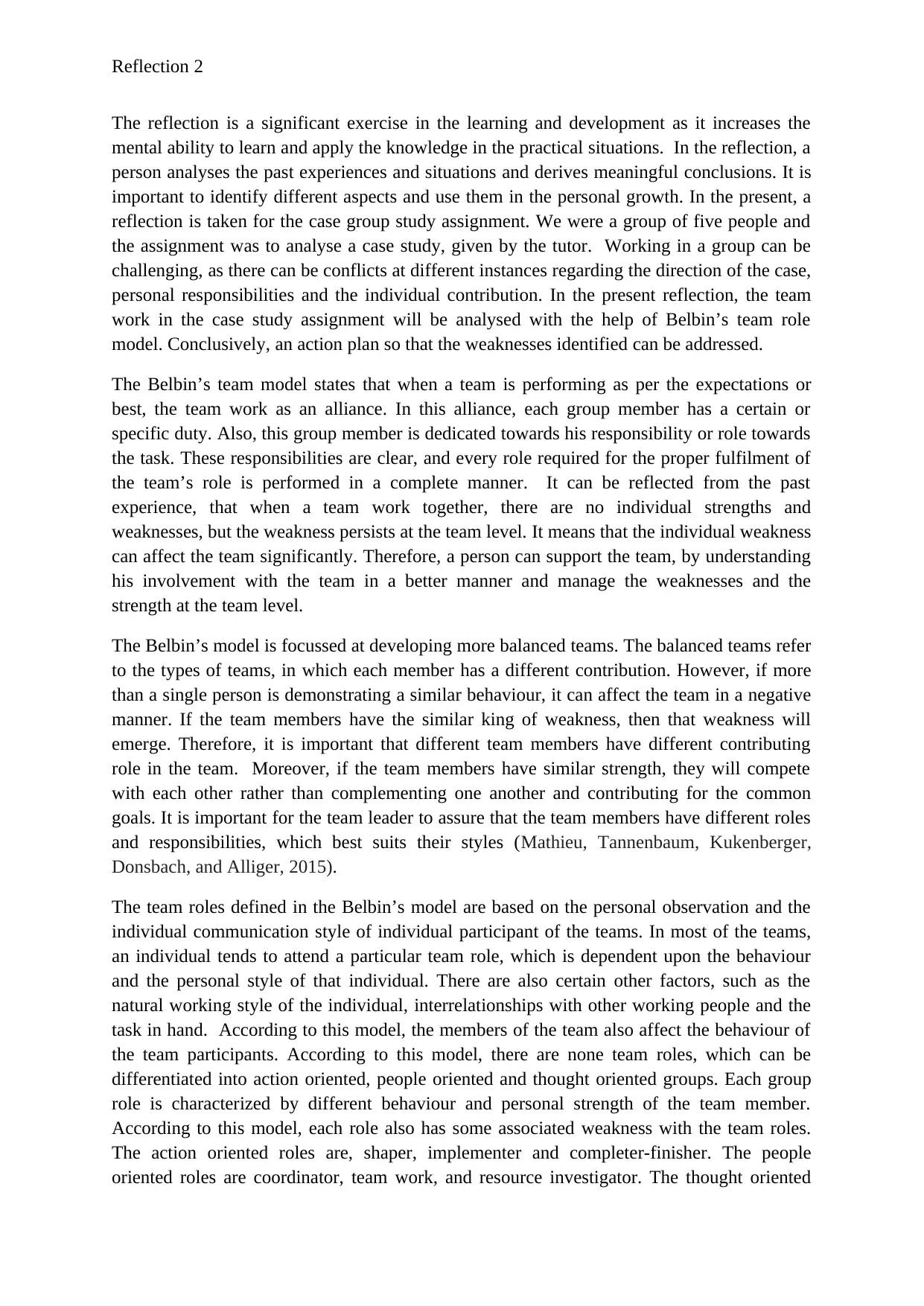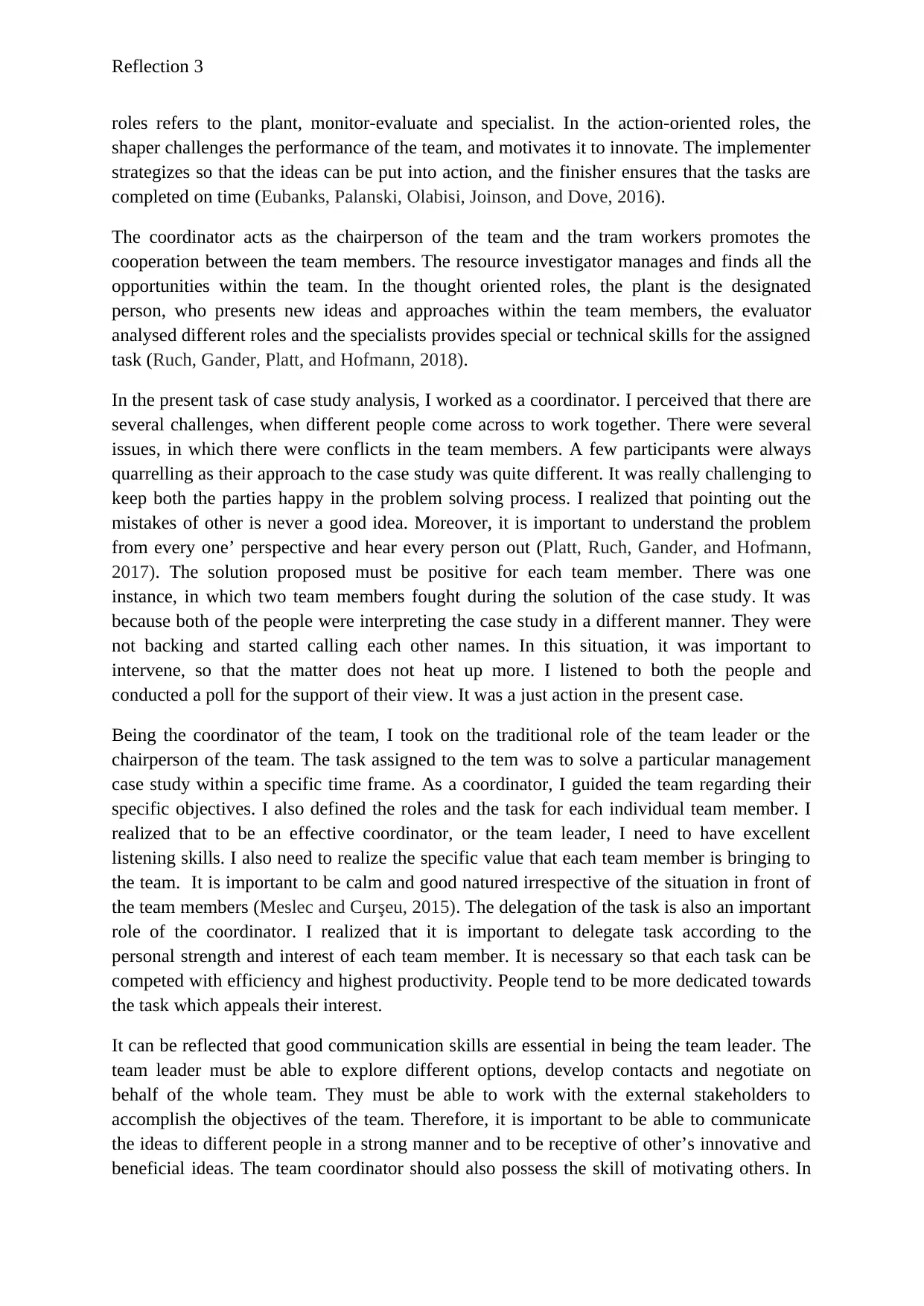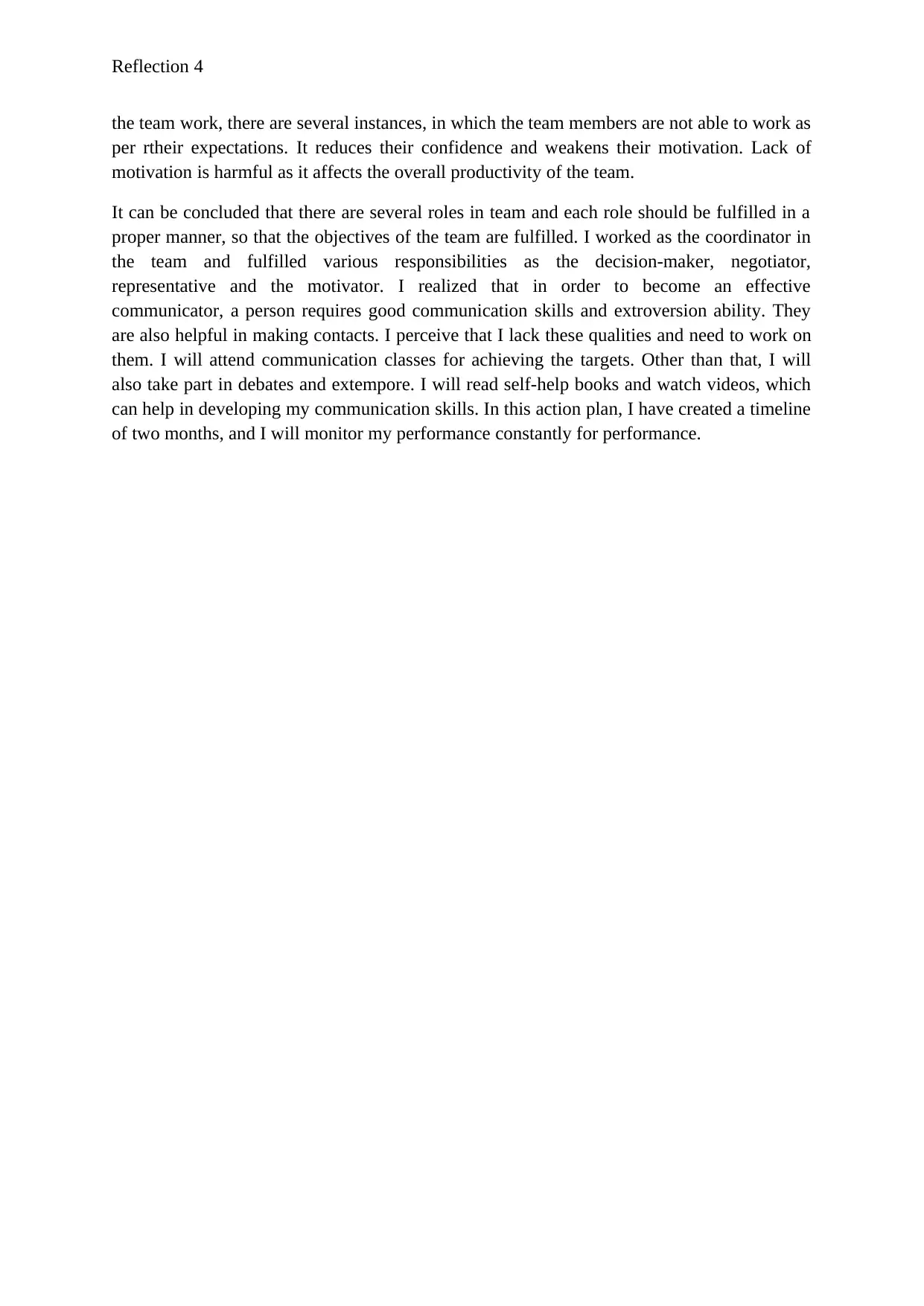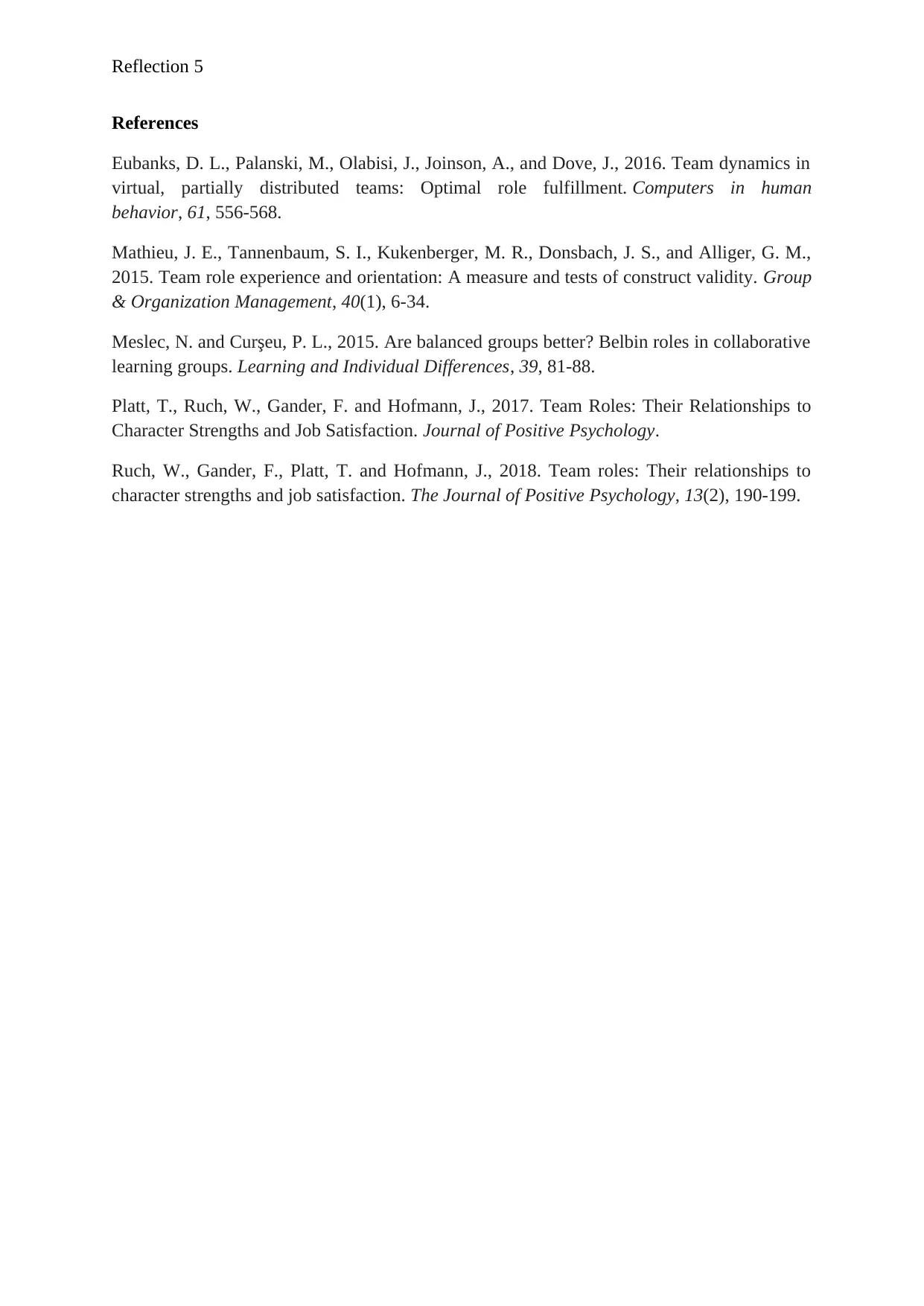Case Study Analysis Reflection: Belbin's Model and Teamwork Dynamics
VerifiedAdded on 2023/06/15
|5
|1808
|163
Essay
AI Summary
This essay provides a reflection on a group case study assignment, analyzing teamwork dynamics through the lens of Belbin's team role model. The author reflects on their role as a coordinator within the team, discussing challenges faced, such as conflicts among team members with differing approaches to the case study. The reflection highlights the importance of effective communication, delegation, and motivation in leadership roles. The author identifies personal weaknesses in communication skills and outlines an action plan for improvement, including attending communication classes, participating in debates, and studying self-help resources. The essay concludes that understanding team roles and fostering strong communication are crucial for achieving team objectives.

Running Head: REFLECTION 1
Reflection
Reflection
Paraphrase This Document
Need a fresh take? Get an instant paraphrase of this document with our AI Paraphraser

Reflection 2
The reflection is a significant exercise in the learning and development as it increases the
mental ability to learn and apply the knowledge in the practical situations. In the reflection, a
person analyses the past experiences and situations and derives meaningful conclusions. It is
important to identify different aspects and use them in the personal growth. In the present, a
reflection is taken for the case group study assignment. We were a group of five people and
the assignment was to analyse a case study, given by the tutor. Working in a group can be
challenging, as there can be conflicts at different instances regarding the direction of the case,
personal responsibilities and the individual contribution. In the present reflection, the team
work in the case study assignment will be analysed with the help of Belbin’s team role
model. Conclusively, an action plan so that the weaknesses identified can be addressed.
The Belbin’s team model states that when a team is performing as per the expectations or
best, the team work as an alliance. In this alliance, each group member has a certain or
specific duty. Also, this group member is dedicated towards his responsibility or role towards
the task. These responsibilities are clear, and every role required for the proper fulfilment of
the team’s role is performed in a complete manner. It can be reflected from the past
experience, that when a team work together, there are no individual strengths and
weaknesses, but the weakness persists at the team level. It means that the individual weakness
can affect the team significantly. Therefore, a person can support the team, by understanding
his involvement with the team in a better manner and manage the weaknesses and the
strength at the team level.
The Belbin’s model is focussed at developing more balanced teams. The balanced teams refer
to the types of teams, in which each member has a different contribution. However, if more
than a single person is demonstrating a similar behaviour, it can affect the team in a negative
manner. If the team members have the similar king of weakness, then that weakness will
emerge. Therefore, it is important that different team members have different contributing
role in the team. Moreover, if the team members have similar strength, they will compete
with each other rather than complementing one another and contributing for the common
goals. It is important for the team leader to assure that the team members have different roles
and responsibilities, which best suits their styles (Mathieu, Tannenbaum, Kukenberger,
Donsbach, and Alliger, 2015).
The team roles defined in the Belbin’s model are based on the personal observation and the
individual communication style of individual participant of the teams. In most of the teams,
an individual tends to attend a particular team role, which is dependent upon the behaviour
and the personal style of that individual. There are also certain other factors, such as the
natural working style of the individual, interrelationships with other working people and the
task in hand. According to this model, the members of the team also affect the behaviour of
the team participants. According to this model, there are none team roles, which can be
differentiated into action oriented, people oriented and thought oriented groups. Each group
role is characterized by different behaviour and personal strength of the team member.
According to this model, each role also has some associated weakness with the team roles.
The action oriented roles are, shaper, implementer and completer-finisher. The people
oriented roles are coordinator, team work, and resource investigator. The thought oriented
The reflection is a significant exercise in the learning and development as it increases the
mental ability to learn and apply the knowledge in the practical situations. In the reflection, a
person analyses the past experiences and situations and derives meaningful conclusions. It is
important to identify different aspects and use them in the personal growth. In the present, a
reflection is taken for the case group study assignment. We were a group of five people and
the assignment was to analyse a case study, given by the tutor. Working in a group can be
challenging, as there can be conflicts at different instances regarding the direction of the case,
personal responsibilities and the individual contribution. In the present reflection, the team
work in the case study assignment will be analysed with the help of Belbin’s team role
model. Conclusively, an action plan so that the weaknesses identified can be addressed.
The Belbin’s team model states that when a team is performing as per the expectations or
best, the team work as an alliance. In this alliance, each group member has a certain or
specific duty. Also, this group member is dedicated towards his responsibility or role towards
the task. These responsibilities are clear, and every role required for the proper fulfilment of
the team’s role is performed in a complete manner. It can be reflected from the past
experience, that when a team work together, there are no individual strengths and
weaknesses, but the weakness persists at the team level. It means that the individual weakness
can affect the team significantly. Therefore, a person can support the team, by understanding
his involvement with the team in a better manner and manage the weaknesses and the
strength at the team level.
The Belbin’s model is focussed at developing more balanced teams. The balanced teams refer
to the types of teams, in which each member has a different contribution. However, if more
than a single person is demonstrating a similar behaviour, it can affect the team in a negative
manner. If the team members have the similar king of weakness, then that weakness will
emerge. Therefore, it is important that different team members have different contributing
role in the team. Moreover, if the team members have similar strength, they will compete
with each other rather than complementing one another and contributing for the common
goals. It is important for the team leader to assure that the team members have different roles
and responsibilities, which best suits their styles (Mathieu, Tannenbaum, Kukenberger,
Donsbach, and Alliger, 2015).
The team roles defined in the Belbin’s model are based on the personal observation and the
individual communication style of individual participant of the teams. In most of the teams,
an individual tends to attend a particular team role, which is dependent upon the behaviour
and the personal style of that individual. There are also certain other factors, such as the
natural working style of the individual, interrelationships with other working people and the
task in hand. According to this model, the members of the team also affect the behaviour of
the team participants. According to this model, there are none team roles, which can be
differentiated into action oriented, people oriented and thought oriented groups. Each group
role is characterized by different behaviour and personal strength of the team member.
According to this model, each role also has some associated weakness with the team roles.
The action oriented roles are, shaper, implementer and completer-finisher. The people
oriented roles are coordinator, team work, and resource investigator. The thought oriented

Reflection 3
roles refers to the plant, monitor-evaluate and specialist. In the action-oriented roles, the
shaper challenges the performance of the team, and motivates it to innovate. The implementer
strategizes so that the ideas can be put into action, and the finisher ensures that the tasks are
completed on time (Eubanks, Palanski, Olabisi, Joinson, and Dove, 2016).
The coordinator acts as the chairperson of the team and the tram workers promotes the
cooperation between the team members. The resource investigator manages and finds all the
opportunities within the team. In the thought oriented roles, the plant is the designated
person, who presents new ideas and approaches within the team members, the evaluator
analysed different roles and the specialists provides special or technical skills for the assigned
task (Ruch, Gander, Platt, and Hofmann, 2018).
In the present task of case study analysis, I worked as a coordinator. I perceived that there are
several challenges, when different people come across to work together. There were several
issues, in which there were conflicts in the team members. A few participants were always
quarrelling as their approach to the case study was quite different. It was really challenging to
keep both the parties happy in the problem solving process. I realized that pointing out the
mistakes of other is never a good idea. Moreover, it is important to understand the problem
from every one’ perspective and hear every person out (Platt, Ruch, Gander, and Hofmann,
2017). The solution proposed must be positive for each team member. There was one
instance, in which two team members fought during the solution of the case study. It was
because both of the people were interpreting the case study in a different manner. They were
not backing and started calling each other names. In this situation, it was important to
intervene, so that the matter does not heat up more. I listened to both the people and
conducted a poll for the support of their view. It was a just action in the present case.
Being the coordinator of the team, I took on the traditional role of the team leader or the
chairperson of the team. The task assigned to the tem was to solve a particular management
case study within a specific time frame. As a coordinator, I guided the team regarding their
specific objectives. I also defined the roles and the task for each individual team member. I
realized that to be an effective coordinator, or the team leader, I need to have excellent
listening skills. I also need to realize the specific value that each team member is bringing to
the team. It is important to be calm and good natured irrespective of the situation in front of
the team members (Meslec and Curşeu, 2015). The delegation of the task is also an important
role of the coordinator. I realized that it is important to delegate task according to the
personal strength and interest of each team member. It is necessary so that each task can be
competed with efficiency and highest productivity. People tend to be more dedicated towards
the task which appeals their interest.
It can be reflected that good communication skills are essential in being the team leader. The
team leader must be able to explore different options, develop contacts and negotiate on
behalf of the whole team. They must be able to work with the external stakeholders to
accomplish the objectives of the team. Therefore, it is important to be able to communicate
the ideas to different people in a strong manner and to be receptive of other’s innovative and
beneficial ideas. The team coordinator should also possess the skill of motivating others. In
roles refers to the plant, monitor-evaluate and specialist. In the action-oriented roles, the
shaper challenges the performance of the team, and motivates it to innovate. The implementer
strategizes so that the ideas can be put into action, and the finisher ensures that the tasks are
completed on time (Eubanks, Palanski, Olabisi, Joinson, and Dove, 2016).
The coordinator acts as the chairperson of the team and the tram workers promotes the
cooperation between the team members. The resource investigator manages and finds all the
opportunities within the team. In the thought oriented roles, the plant is the designated
person, who presents new ideas and approaches within the team members, the evaluator
analysed different roles and the specialists provides special or technical skills for the assigned
task (Ruch, Gander, Platt, and Hofmann, 2018).
In the present task of case study analysis, I worked as a coordinator. I perceived that there are
several challenges, when different people come across to work together. There were several
issues, in which there were conflicts in the team members. A few participants were always
quarrelling as their approach to the case study was quite different. It was really challenging to
keep both the parties happy in the problem solving process. I realized that pointing out the
mistakes of other is never a good idea. Moreover, it is important to understand the problem
from every one’ perspective and hear every person out (Platt, Ruch, Gander, and Hofmann,
2017). The solution proposed must be positive for each team member. There was one
instance, in which two team members fought during the solution of the case study. It was
because both of the people were interpreting the case study in a different manner. They were
not backing and started calling each other names. In this situation, it was important to
intervene, so that the matter does not heat up more. I listened to both the people and
conducted a poll for the support of their view. It was a just action in the present case.
Being the coordinator of the team, I took on the traditional role of the team leader or the
chairperson of the team. The task assigned to the tem was to solve a particular management
case study within a specific time frame. As a coordinator, I guided the team regarding their
specific objectives. I also defined the roles and the task for each individual team member. I
realized that to be an effective coordinator, or the team leader, I need to have excellent
listening skills. I also need to realize the specific value that each team member is bringing to
the team. It is important to be calm and good natured irrespective of the situation in front of
the team members (Meslec and Curşeu, 2015). The delegation of the task is also an important
role of the coordinator. I realized that it is important to delegate task according to the
personal strength and interest of each team member. It is necessary so that each task can be
competed with efficiency and highest productivity. People tend to be more dedicated towards
the task which appeals their interest.
It can be reflected that good communication skills are essential in being the team leader. The
team leader must be able to explore different options, develop contacts and negotiate on
behalf of the whole team. They must be able to work with the external stakeholders to
accomplish the objectives of the team. Therefore, it is important to be able to communicate
the ideas to different people in a strong manner and to be receptive of other’s innovative and
beneficial ideas. The team coordinator should also possess the skill of motivating others. In
⊘ This is a preview!⊘
Do you want full access?
Subscribe today to unlock all pages.

Trusted by 1+ million students worldwide

Reflection 4
the team work, there are several instances, in which the team members are not able to work as
per rtheir expectations. It reduces their confidence and weakens their motivation. Lack of
motivation is harmful as it affects the overall productivity of the team.
It can be concluded that there are several roles in team and each role should be fulfilled in a
proper manner, so that the objectives of the team are fulfilled. I worked as the coordinator in
the team and fulfilled various responsibilities as the decision-maker, negotiator,
representative and the motivator. I realized that in order to become an effective
communicator, a person requires good communication skills and extroversion ability. They
are also helpful in making contacts. I perceive that I lack these qualities and need to work on
them. I will attend communication classes for achieving the targets. Other than that, I will
also take part in debates and extempore. I will read self-help books and watch videos, which
can help in developing my communication skills. In this action plan, I have created a timeline
of two months, and I will monitor my performance constantly for performance.
the team work, there are several instances, in which the team members are not able to work as
per rtheir expectations. It reduces their confidence and weakens their motivation. Lack of
motivation is harmful as it affects the overall productivity of the team.
It can be concluded that there are several roles in team and each role should be fulfilled in a
proper manner, so that the objectives of the team are fulfilled. I worked as the coordinator in
the team and fulfilled various responsibilities as the decision-maker, negotiator,
representative and the motivator. I realized that in order to become an effective
communicator, a person requires good communication skills and extroversion ability. They
are also helpful in making contacts. I perceive that I lack these qualities and need to work on
them. I will attend communication classes for achieving the targets. Other than that, I will
also take part in debates and extempore. I will read self-help books and watch videos, which
can help in developing my communication skills. In this action plan, I have created a timeline
of two months, and I will monitor my performance constantly for performance.
Paraphrase This Document
Need a fresh take? Get an instant paraphrase of this document with our AI Paraphraser

Reflection 5
References
Eubanks, D. L., Palanski, M., Olabisi, J., Joinson, A., and Dove, J., 2016. Team dynamics in
virtual, partially distributed teams: Optimal role fulfillment. Computers in human
behavior, 61, 556-568.
Mathieu, J. E., Tannenbaum, S. I., Kukenberger, M. R., Donsbach, J. S., and Alliger, G. M.,
2015. Team role experience and orientation: A measure and tests of construct validity. Group
& Organization Management, 40(1), 6-34.
Meslec, N. and Curşeu, P. L., 2015. Are balanced groups better? Belbin roles in collaborative
learning groups. Learning and Individual Differences, 39, 81-88.
Platt, T., Ruch, W., Gander, F. and Hofmann, J., 2017. Team Roles: Their Relationships to
Character Strengths and Job Satisfaction. Journal of Positive Psychology.
Ruch, W., Gander, F., Platt, T. and Hofmann, J., 2018. Team roles: Their relationships to
character strengths and job satisfaction. The Journal of Positive Psychology, 13(2), 190-199.
References
Eubanks, D. L., Palanski, M., Olabisi, J., Joinson, A., and Dove, J., 2016. Team dynamics in
virtual, partially distributed teams: Optimal role fulfillment. Computers in human
behavior, 61, 556-568.
Mathieu, J. E., Tannenbaum, S. I., Kukenberger, M. R., Donsbach, J. S., and Alliger, G. M.,
2015. Team role experience and orientation: A measure and tests of construct validity. Group
& Organization Management, 40(1), 6-34.
Meslec, N. and Curşeu, P. L., 2015. Are balanced groups better? Belbin roles in collaborative
learning groups. Learning and Individual Differences, 39, 81-88.
Platt, T., Ruch, W., Gander, F. and Hofmann, J., 2017. Team Roles: Their Relationships to
Character Strengths and Job Satisfaction. Journal of Positive Psychology.
Ruch, W., Gander, F., Platt, T. and Hofmann, J., 2018. Team roles: Their relationships to
character strengths and job satisfaction. The Journal of Positive Psychology, 13(2), 190-199.
1 out of 5
Related Documents
Your All-in-One AI-Powered Toolkit for Academic Success.
+13062052269
info@desklib.com
Available 24*7 on WhatsApp / Email
![[object Object]](/_next/static/media/star-bottom.7253800d.svg)
Unlock your academic potential
Copyright © 2020–2025 A2Z Services. All Rights Reserved. Developed and managed by ZUCOL.





